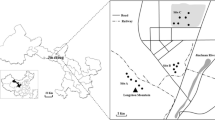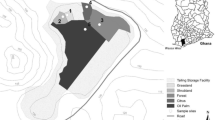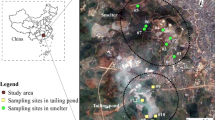Abstract
Metal contamination is a recurring problem in Peru, caused mainly by mine tailings from a past active mining activity. The Ancash region has the largest number of environmental liabilities, which mobilizes high levels of metals and acid drainages into soils and freshwater sources, posing a standing risk on human and environmental health. Native plant species spontaneously growing on naturally acidified soils and acid mine tailings show a unique tolerance to high metal concentrations and are thus potential candidates for soil phytoremediation. However, little is known about their propagation capacity and metal accumulation under controlled conditions. In this study, we aimed at characterizing nine native plant species, previously identified as potential hyperaccumulators, from areas impacted by mine tailings in the Ancash region. Plants were grown on mine soils under greenhouse conditions during 5 months, after which the concentration of Cd, Cu, Ni, Pb, and Zn was analyzed in roots, shoots, and soils. The bioaccumulation (BAF) and translocation factor (TF) were calculated to determine the amount of each metal accumulated in the roots and shoots and to identify which species could be better suited for phytoremediation purposes. Soil samples contained high Cd (6.50–49.80 mg/kg), Cu (159.50–1187.00 mg/kg), Ni (3.50–8.70 mg/kg), Pb (1707.00–4243.00 mg/kg), and Zn (909.00–7100.00 mg/kg) concentrations exceeding national environmental quality standards. After exposure to mine tailings, concentrations of metals in shoots were highest in Werneria nubigena (Cd, 16.68 mg/kg; Cu, 41.36 mg/kg; Ni, 26.85 mg/kg; Zn, 1691.03 mg/kg), Pennisetum clandestinum (Pb, 236.86 mg/kg), and Medicago lupulina (Zn, 1078.10 mg/kg). Metal concentrations in the roots were highest in Juncus bufonius (Cd, 34.34 mg/kg; Cu, 251.07 mg/kg; Ni, 6.60 mg/kg; Pb, 718.44 mg/kg) and M. lupulina (Zn, 2415.73 mg/kg). The greatest BAF was calculated for W. nubigena (Cd, 1.92; Cu, 1.20; Ni, 6.50; Zn, 3.50) and J. bufonius (Ni, 3.02; Zn, 1.30); BCF for Calamagrostis recta (Cd, 1.09; Cu, 1.80; Ni, 1.09), J. bufonius (Cd, 3.91; Cu, 1.79; Ni, 18.36), and Achyrocline alata (Ni, 137; Zn, 1.85); and TF for W. nubigena (Cd, 2.36; Cu, 1.70; Ni, 2.42; Pb, 1.17; Zn, 1.43), A. alata (Cd, 1.14; Pb, 1.94), J. bufonius (Ni, 2.72; Zn, 1.63), and P. clandestinum (Zn, 1.14). Our results suggest that these plant species have a great potential for soil phytoremediation, given their capability to accumulate and transfer metals and their tolerance to highly metal-polluted environments in the Andean region.




Similar content being viewed by others
References
Ali H, Khan E, Sajad MA (2013) Phytoremediation of heavy metals—concepts and applications. Chemosphere 91:869–881. https://doi.org/10.1016/j.chemosphere.2013.01.075
Almeida CM, Mucha AP, Vasconcelos MT (2006) Comparison of the role of the sea club-rush Scirpus maritimus and the sea rush Juncus maritimus in terms of concentration, speciation and bioaccumulation of metals in the estuarine sediment. Environ Pollut 142:151–159
Baker AJM, Brooks RR (1989) Terrestrial higher plants which hyperaccumulate metallic elements – a review of their distribution. Ecol Phytochem Biorecovery 1:81–126
Bech J, Abreu MM, Chon HT, Roca N (2014) Remediation of potentially toxic elements in contaminated soils. In: Bini, C., Bech, J. (Eds.), PHEs, environment and human health. Springer, Dordrecht, Heidelberg, New York, London, pp. 253–308
Bech J, Duran P, Roca N, Poma W, Sánchez I, Barceló J, Boluda R, Roca-Pérez L, Poschenrieder C (2012) Shoot accumulation of several trace elements in native plant species from contaminated soils in the Peruvian Andes. J Geochem Explor 113:106–111. https://doi.org/10.1016/j.gexplo.2011.04.007
Bech J, Poschenrieder C, Llugany M, Barceló J, Tume P, Tobías FJ, Barranzuela JL, Vásquez ER (1997) Arsenic and heavy metal contamination of soil and vegetation around a copper mine in Northern Peru. Sci Total Environ 203:83–91
Bech J, Roca N, Tume P, Ramos-Miras J, Boluda R (2016) Screening for new accumulator plants in potential hazards elements polluted soil surrounding Peruvian mine tailings. CATENA 136:66–73. https://doi.org/10.1016/j.catena.2015.07.009
Bobadilla M, Aliaga E, Yupanqui E, Palomino E (2013) A phytoremediation approach using Calamagrostis ligulata and Juncus imbricatus in Andean wetlands of Peru. Environ Monit Assess 185:323–334. https://doi.org/10.1007/s10661-012-2552-x
Burns PJ (2010) Geochemical analysis of waters in a tropical glacial valley, Cordillera Blanca, Peru (Senior Honors Thesis). Ohio State University, Columbus, Ohio. In: USA
Caille N, Zhao FJ, McGrath SP (2005) Comparison of root absorption translocation and tolerance of arsenic in the hyperaccumulator Pteris vittata and the nonhyperaccumulator Pteris tremula. New Phytol Vol 165:755–761. https://doi.org/10.1111/j.1469-8137.2004.01239.x
Callahan DL, Baker AJ, Kolev SD, Wedd AG (2006) Metal ion ligands in hyperaccumulating plants. J Biol Inorg Chem 11:2–12
Chaney RL, Malik M, Liy M, Brown SL, Brewer EP, Angle JS, Bakera JM (1997) Phytoremediation of soil metals. Curr Opin Biotech 8:279–284. https://doi.org/10.1016/S0958-1669(97)80004-3
Chekol T, Vough LR (2002) Assessing the phytoremediation potential of tall fescue and sericea lespedeza for organic contaminants in soil. Remediation 12:117–128. https://doi.org/10.1002/rem.10037
DESA (Dirección Ejecutiva de Salud Ambiental) (2002a). Grupo Técnico Control y Recuperación de la Calidad de las Aguas del río Santa. Comisión Ambiental Regional Sierra Ancash - CAR, Ancash
DESA (Dirección Ejecutiva de Salud Ambiental) (2002b). Vertimientos y pasivos ambientales en la cuenca del río Santa
Favas Paulo JC, Pratas J, Prasad MNV (2012) Accumulation of arsenic by aquatic plants in large-scale field conditions: opportunities for phytoremediation and bioindication. Sci Total Environ 433:390–397. https://doi.org/10.1016/j.scitotenv.2012.06.091
Fortner SK, Mark BG, McKenzie JM, Bury J, Trierweiler A, Baraer M, Burns PJ, Munk LA (2011) Elevated stream trace and minor element concentrations in the foreland of receding tropical glaciers. Appl Geochem 26(11):1792–1801
Gajić G, Djurdjević L, Kostić O, Jarić S, Mitrović M, Stevanović B, Pavlović P (2016) Assessment of the phytoremediation potential and an adaptive response of Festuca rubra L. sown on fly ash deposits: native grass has a pivotal role in ecorestoration management. Ecol Eng 93:250–261. https://doi.org/10.1016/j.ecoleng.2016.05.021
Ginocchio R, Hepp J, Bustamante E, Silva Y, De la Fuente LM, Casale JF, De la Harpe JP, Urrestarazu P, Anic V, Montenegro G (2008) Importance of water quality on plant abundance and diversity in high-alpine meadows of the Yerba Loca Natural Sanctuary at the Andes of north-central Chile. Rev Chil Hist Nat 81:469–488. https://doi.org/10.4067/S0716-078X2008000400003
Gray CW, Dunham SJ, Dennis PG, Zhao FJ, McGrath SP (2006) Field evaluation of in situ remediation of a heavy metal contaminated soil using lime and red-mud. Environ Pollut 142(3):530–539. https://doi.org/10.1016/j.envpol.2005.10.017
Hassani AH, Nouri J, Mehregan I, Moattar F, Sadeghi Benis MR (2014) Phytoremediation of soils contaminated with heavy metals resulting from acidic sludge of Eshtehard Industrial Town using native pasture plants. J Environ Earth Sci 4(19)
Kang C-H, Kwon Y-J, So J-S (2016) Bioremediation of heavy metals by using bacterial mixtures. Ecol Eng 89:64–69. https://doi.org/10.1016/j.ecoleng.2016.01.023
Lehmann C, Rebele F (2004) Assessing the potential for cadmium phytoremediation with
Loayza-Muro R (2016) Daños ambientales de la minería en el Perú: ¿Qué hacer con ellos? Metas del Perú al Bicentenario. 1a edición, Lima: Consorcio de Universidades. 370 p
Lock OR (2006) Diversidad química el género werneria. Rev. Soc. Quím. Perú [online] 72(1):32–48
Malik RN, Husain SZ, Nazir I (2010) Heavy metal contamination and accumulation in soil and wild plant species from industrial area of Islamabad, Pakistan. Pak J Bot 42(1):291–301
McGrath SP, Zhao FJ (2003) Phytoextraction of metals and metalloids from contaminated soils. Curr Opin Biotechnol 14:1–6
Ministerio de energía y minas (MINEM) (2016). Inventory of mining liabilities. [online]. Available: http://www.minem.gob.pe/_legislacionM.php?idSector=1&idLegislacion=10991
Ministerio de Energía y Minas (MINEM) (1998) Estudio de evaluación ambiental territorial y de planeamiento para la reducción o eliminación de la contaminación de origen minero en la cuenca del río Santa. Dirección General de Asuntos Ambientales, Lima. In: Peru
Ministerio del Ambiente (MINAM) (2017) Estándares de Calidad Ambiental (ECA) para Suelo. Decreto Supremo No 011–2017-MINAM
Najeeb U, Ahmad W, Zia M, Zaffar M, Zhou W (2017) Enhancing the lead phytostabilization in wetland plant Juncus effusus L. through somaclonal manipulation and EDTA enrichment. Arabian journal of chemistry, Vol 10, Supplement 2: S3310-S3317. https://doi.org/10.1016/j.arabjc.2014.01.009
Najeeb U, Jilani G, Ali S, Sarwar M, Xu L, Zhou W (2011) Insights into cadmium induced physiological and ultra-structural disorders in Juncus effusus L. and its remediation through exogenous citric acid. J Hazard Mater 186(1):565–574. https://doi.org/10.1016/j.jhazmat.2010.11.037
Najeeb U, Xu L, Ali S, Jilani G, Gong HJ, Shen WQ, Zhou WJ (2009) Citric acid enhances the phytoextraction of manganese and plant growth by alleviating the ultrastructural damages in Juncus effusus L. J Hazard Mater 170(2–3):1156–1163. https://doi.org/10.1016/j.jhazmat.2009.05.084
Ñañez D (2016) Estudio y selección de especies vegetales con potencial biorremediador en drenajes ácidos de roca y relaves minerales de la cuenca del río Santa (Áncash, Perú). Bachelor dissertation, Dept. Biochemistry. and Molecular Biology., Cayetano Heredia Univ., Lima-Perú
Nazir A, Malik RN, Ajaib M, Khan N, Siddiqui MF (2011) Hyperaccumulators of heavy metals of industrial areas of Islamabad and Rawalpindi. Pakistan J Bot 43(4):1925–1933
Okem A, Kulkarni MG, Van Staden J (2015) Enhancing phytoremediation potential of Pennisetum clandestinum Hochst in cadmium-contaminated soil using smoke-water and smoke-isolated Karrikinolide. Int J Phytoremediation 17:1046–1052. https://doi.org/10.1080/15226514.2014.981245
Padmavathiamma PK, Li LY (2009) Phytoremediation of metal contaminated soil in temperate humid regions of British Columbia, Canada. Int J Phytoremediation 11(6):575–590. https://doi.org/10.1080/15226510902717606
Palomino EJ (2007) Sistemas de humedales para la Biorremediación de drenajes ácidos de mina o roca en Ancash - Perú. PhD Thesis, Dept. Environ. Sci., National Trujillo Univ., Lima, Peru
Palomino E, Mostacero J, Mejía F, Bobadilla M, Leyva M, Polo R (2008) Biorremediación de drenajes ácidos con humedales altoandinos. Ancash–Perú. Memorias del Congreso Internacional Gestión Sostenible del Agua: Reutilización, Tratamiento y Evaluación de la Calidad. Medellín
Power C, Ramasamy M, MacAskill D, Shea J, MacPhee J, Mayich D, Baechler F, Mkandawire M. (2017) Five-year performance monitoring of a high-density polyethylene (HDPE) cover system at a reclaimed mine waste rock pile in the Sydney Coalfield (Nova Scotia, Canada). Environ Sci Pollut Res Int 1–19. https://doi.org/10.1007/s11356-017-0288-4
Rivera H, Chira J, Campián M, Cornelio F (2008) Análisis correlacional y evolutivo de los metales pesados en sedimentos del río Santa entre Huaraz–Carhuaz, Departamento de Ancash. Rev Inst Invest FIGMMG 11:19–24
Robinson B, Anderson C (2007) Phytoremediation in New Zealand and Australia. In: Willey N (ed) Phytoremediation. Methods in biotechnology, vol 23. Humana Press
Rodríguez R, Oldecop L, Linares R, Salvadó V (2009) Los grandes desastres medio ambientales producidos por la actividad minero-metalúrgica a nivel mundial: causas y consecuencias ecológicas y sociales. Revista del Instituto de Investigaciones 12(24):7–25 Lima: Universidad Nacional Mayor de San Marcos
Romero A, Flores S, Medina R (2008) Estudio de los metales pesados en el relave abandonado de Ticapampa. Rev Inst Inves FIGMMG 11:13–16
Susarla S (2002) Phytoremediation: an ecological solution to organic chemical contamination. J Ecol Eng 18(5):647–658. https://doi.org/10.1007/978-1-59745-098-0_31
Sahuquillo A, Rigol A, Rauret G (2003) Overview of the use of leaching/extraction tests forrisk assessment of trace metals in contaminated soils and sediments. Trends Anal Chem 22:152–159. https://doi.org/10.1016/S0165-9936(03)00303-0
Santofimia E, López-Pamo E, Palomino EJ, González-Toril E, Aguilera A (2017) Acid rock drainage in Nevado Pastoruri glacier area (Huascarán National Park, Perú): hydrochemical and mineralogical characterization and associated environmental implications. Environ Sci Pollut Res 24:25243–25259
Schmidt AC, Mattusch J, Reisser W, Wennrich R (2004) Uptake and accumulation behaviour of angiosperms irrigated with solutions of different arsenic species. Chemosphere 56:305–313
Sharifi Z, Sinegani A, Shariati S (2012) Potential of indigenous plant species for the phytoremediation of arsenic contaminated land in Kurdistan (Iran). Soil Sediment Contam Int J 21(5):557–573. https://doi.org/10.1080/15320383.2012.678951
Sheoran AS (2006) Performance of three aquatic plant species in bench-scale acid mine drainage wetland test cells. Mine Water Environ 25:23–36. https://doi.org/10.1007/s10230-006-0105-7
Suchkova N, Darakas E, Ganoulis J (2010) Phytoremediation as a prospective method for rehabilitation of areas contaminated by long-term sewage sludge storage: a Ukrainian–Greek case study. Ecol Eng 36:373–378. https://doi.org/10.1016/j.ecoleng.2009.11.002
Sun M, Fu D, Teng Y, Shen Y, Luo Y, Li Z, Christie P (2011) In situ phytoremediation of PAH-contaminated soil by intercropping alfalfa (Medicago sativa L.) with tall fescue (Festuca arundinacea Schreb.) and associated soil microbial activity. J Soils Sediments 11:980–989. https://doi.org/10.1007/s11368-011-0382-z
Sun Y, Zhou Q, Diao C (2008) Effects of cadmium and arsenic on growth and metal accumulation of Cd-hyperaccumulator Solanum nigrum L. Bioresour Technol 99:1103–1110
Syranidou E, Christofilopoulos S, Kalogerakis N (2017) Juncus spp.—the helophyte for all (phyto) remediation purposes? In New Biotechnol 38(B):s 43–s 55. https://doi.org/10.1016/j.nbt.2016.12.005
Temel F, Avcı E, Ardalı Y (2017) Application of horizontal subsurface flow constructed wetland systems for domestic wastewater treatment: a case study, Kızılcaören. Turkish Journal of Agriculture – Food Science and Technology 5(5). https://doi.org/10.24925/turjaf.v5i5.493-501.1063
Trakal L, Martínez-Fernández D, Vítková M, Komárek M (2013) Utilization and supplementation of phytoextraction potential of some terrestrial plants in metal-contaminated soils, chapter: phytoextraction of metals: modeling root metal uptake and associated processes. Publisher: Springer, New York, USA., Editors: Ansari AA, Gill SS, Gill R, Lanza GR, Lee N
US Environmental Protection Agency. (1994). Determination of metals and trace elements in water and wastes by inductively coupled plasma atomic emission spectrometry. Method 200.7, Revision 4.4, Methods for the determination of metals in the environmental samples, Supplement 1. EPA-600/R-94-111. Cincinnati, OH
Vieira JD, Stefenon VM (2017) Soil bioremediation in heavy metal contaminated mining areas: a microbiological/biotechnological point of view. J Adv Microbiol 4(1):2456–7116. https://doi.org/10.9734/JAMB/2017/33782
Yoon J, Cao X, Zhou Q, Ma LQ (2006) Accumulation of Pb, Cu, and Zn in native plants growing on a contaminated Florida site. Sci Total Environ 368:456–464. https://doi.org/10.1016/j.scitotenv.2006.01.016
Yupari A (2003) Pasivos ambientales mineros en Sudamérica. Informe elaborado para la para CEPAL, el Instituto Federal de Geociencias y Recursos Naturales, BGR, y el Servicio Nacional de Geología y Minería, SERNAGEOMIN. Santiago: CEPAL
Zhang Z, Rengel Z, Chang H, Meney K, Pantelic L, Tomanovic R (2012) Phytoremediation potential of Juncus subsecundus in soils contaminated with cadmium and Polynuclear Aromatic Hydrocarbons (PAHs). Geoderma 175–176:1–8. https://doi.org/10.1016/j.geoderma.2012.01.020
Zu YQ, Li Y, Chen JJ, Chen HY, Qin L, Christian S (2005) Hyperaccumulation of Pb, Zn and Cd in herbaceous plants grown on lead–zinc mining area in Yunnan, China. Environ Int 31:755–762. https://doi.org/10.1016/j.envint.2005.02.004
Acknowledgements
This work was funded by the National Innovation Program for Competitiveness and Productivity (Innovate Peru, contract no. 162-PNICP-PIAP-2015). We are also very thankful to Ing. Zenobio Ospina Oré for his invaluable assistance with plant propagation in greenhouse facilities and Dr. Edwin J. Palomino for organization and field logistics in Huaraz.
Author information
Authors and Affiliations
Corresponding author
Additional information
Responsible editor: Elena Maestri
Electronic supplementary material
ESM 1
(DOCX 35 kb)
Rights and permissions
About this article
Cite this article
Chang Kee, J., Gonzales, M.J., Ponce, O. et al. Accumulation of heavy metals in native Andean plants: potential tools for soil phytoremediation in Ancash (Peru). Environ Sci Pollut Res 25, 33957–33966 (2018). https://doi.org/10.1007/s11356-018-3325-z
Received:
Accepted:
Published:
Issue Date:
DOI: https://doi.org/10.1007/s11356-018-3325-z




